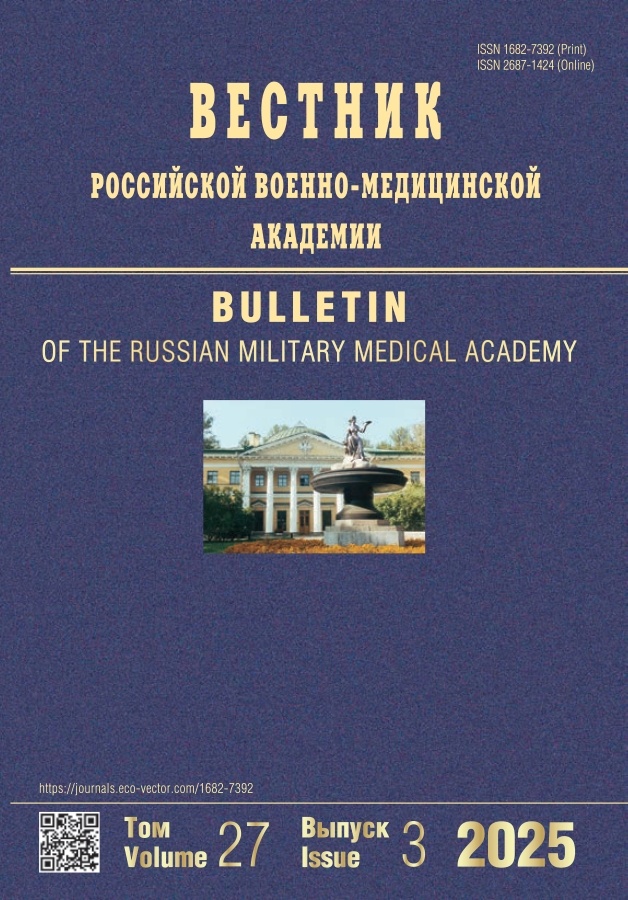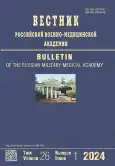壳聚糖凝胶形式的局部止血剂——止住腹腔内持续出血的有效技术(实验研究)
- 作者: Golovko K.P.1, Nosov A.M.1, Yudin A.B.2, Samokhvalov I.M.1, Demchenko K.N.1, Pichugin A.A.1, Kovalevskiy A.Y.1
-
隶属关系:
- Kirov Military Medical Academy
- State Research Testing Institute Military Medicine
- 期: 卷 26, 编号 1 (2024)
- 页面: 61-70
- 栏目: Original Study Article
- URL: https://journals.rcsi.science/1682-7392/article/view/255216
- DOI: https://doi.org/10.17816/brmma562796
- ID: 255216
如何引用文章
详细
在医疗后送阶段,出血是 "有可能获救"的伤员群体中最常见的死亡原因。为止住持续的外部出血,已开发出大量医疗器械:局部止血剂(敷料、绷带、粉剂)、止血带、压缩器等。止住持续的内出血仍是军事医学急需解决的问题。到目前为止,在到达合格的护理阶段之前,不可能停止腔内出血。为此,正在开发在入院前阶段止住(控制)腔内出血的新方法和新技术。作为研究工作的一部分,开发了一种凝胶形式的壳聚糖制剂,用于止住内出血。在大型实验动物腹腔持续出血模型实验中,对所开发产品的功效进行了评估,结果表明其止血效率很高。根据术中肝脏伤口出血的严重程度,研制的局部止血剂,经腹腔穿刺注入,可实现肝创面术中出血3级止血,而且不会引起周围器官和组织的炎症变化。与对照组相比,使用局部止血剂可避免实验组出现致命结果(3 只动物中 1 只出现致命结果)。血红蛋白和红细胞计数的动态变化表明,实验组动物在使用局部止血剂后几乎立即止血,而对照组动物的止血在整个观察期间一直不稳定。肝脏制剂的组织学研究结果证实,使用局部生物相容性止血剂可持续止血,不会出现局部炎症反应或坏死。所创造的技术可以从急救阶段开始使用,因为它解决了在医院前阶段阻止腔内出血的问题,改善腹部受伤伤员的治疗效果。
作者简介
Konstantin P. Golovko
Kirov Military Medical Academy
Email: vmeda-nio@mil.ru
ORCID iD: 0000-0002-1584-1748
SPIN 代码: 2299-6153
MD, Dr. Sci. (Med.), associate professor
俄罗斯联邦, Saint PetersburgArtem M. Nosov
Kirov Military Medical Academy
Email: vmeda-nio@mil.ru
ORCID iD: 0000-0001-9977-6543
SPIN 代码: 7386-3225
MD, Cand. Sci. (Med.)
俄罗斯联邦, Saint PetersburgAndrey B. Yudin
State Research Testing Institute Military Medicine
Email: yudin_a73@mail.ru
ORCID iD: 0000-0001-5041-7267
SPIN 代码: 7060-1221
MD, Cand. Sci. (Med.)
俄罗斯联邦, Saint PetersburgIgor M. Samokhvalov
Kirov Military Medical Academy
Email: igor-samokhvalov@mail.ru
ORCID iD: 0000-0003-1398-3467
SPIN 代码: 4590-8088
MD, Dr. Sci. (Med.), professor
俄罗斯联邦, Saint PetersburgKonstantin N. Demchenko
Kirov Military Medical Academy
Email: vmeda-nio@mil.ru
ORCID iD: 0000-0001-5437-1163
SPIN 代码: 7549-2959
MD, Cand. Sci. (Med.)
俄罗斯联邦, Saint PetersburgArtem A. Pichugin
Kirov Military Medical Academy
Email: vmeda-nio@mil.ru
ORCID iD: 0009-0001-0414-6192
SPIN 代码: 9813-9694
MD, Cand. Sci. (Med.)
俄罗斯联邦, Saint PetersburgArkady Ya. Kovalevskiy
Kirov Military Medical Academy
编辑信件的主要联系方式.
Email: vmeda-nio@mil.ru
ORCID iD: 0009-0002-5525-908X
SPIN 代码: 1630-7857
clinical resident
俄罗斯联邦, Saint Petersburg参考
- Samokhvalov IM, Goncharov AV, Chirskij VS, et al. “Potentially survivable” casualties - reserve to reduce pre-hospital lethaility in injuries and traumas. Emergency medical care. 2019;20(3):10–17. EDN: CUUXRN doi: 10.24884/2072-6716-2019-0-3-10-17
- Yareshko VG, Mikheev YA, Otarashvili KN. The concept of damage control in trauma (surgeon’s view). Medicine of urgent conditions. 2014;(7):176–180. EDN: TZCEVX (In Russ.).
- Hoencamp R, Vermetten E, Tan ECTH, et al. Systematic review of the prevalence and characteristics of battle casualties from NATO coalition forces in Iraq and Afghanistan. Injury. 2014;45(7): 1028–1034. doi: 10.1016/j.injury.2014.02.012
- Bonanno FG. Management of hemorrhagic shock: Physiology approach, timing and strategies. J Clin Med. 2022;7(2):110–113. doi: 10.3390/jcm12010260
- Rall JM, Redman TT, Ross EM, et al. Comparison of zone 3 resuscitative endovascular balloon occlusion of the aorta and the abdominal aortic and junctional tourniquet in a model of junctional hemorrhage in swine. J Surg Res. 2018;226:31–39. doi: 10.1016/j.jss.2017.12.039
- Kheirabadi BS, Terrazas IB, Miranda N, et al. Physiological consequences of abdominal aortic and junctional tourniquet (AAJT) application to control hemorrhage in a swine model. Shock. 2018;46(3S):160–166. doi: 10.1097/SHK.0000000000000651
- Duggan M, Rago A, Sharma U, et al. Self-expanding polyurethane polymer improves survival in a model of noncompressible massive abdominal hemorrhage. J Trauma Acute Care Surg. 2013;74(6): 1462–1467. doi: 10.1097/TA.0b013e31828da937
- Rago AP, Duggan MJ, Beagle J, et al. Self-expanding foam for prehospital treatment of intra-abdominal hemorrhage: 28-day survival and safety. J Trauma Acute Care Surg. 2014;77(3):127–133. doi: 10.1097/TA.0000000000000380
- Golovko KP, Samokhvalov IM, Grishin MS, et al. Use of a local hemostatic agent based on chitosan and external compression of the abdominal area to control intra-abdominal bleeding. Bulletin of the Russian Military Medical Academy. 2022;24(1):43–54. EDN: BUFMLE doi: 10.17816/brmma91155
- Cantle PM, Hurlet MJ, Swartz MD. Methods for early control of abdominal hemorrhage: an assessment of potential benefit. J Spec Oper Med: Peer Rev J SOF Med Prof. 2018;18(2):98–104. doi: 10.55460/I0EU-SQE7
补充文件












